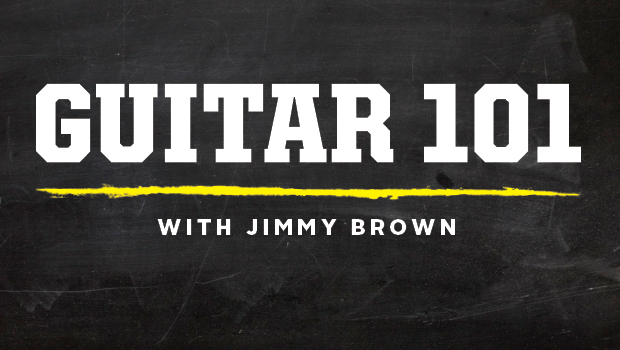Guitar 101: How To Play Fast, Part 1

One needn’t be a technical virtuoso to play fast…just resourceful, pragmatic and willing to shamelessly exploit any "trick" in order to achieve the desired effect. The key is to find the easiest way to get the sound you want, and this entails experimenting with different fingering patterns and techniques.
Technical problems should be approached creatively; play smarter, not harder! With this mind-set, and the benefit of a little direction and a reasonably consistent practice schedule (20-40 minutes daily), you’ll be able to develop an arsenal of flashy "speed licks" that you can execute with minimal warm-up…even on a bad day.
The intent of this lesson is to show beginner and intermediate guitarists several ways of creating a "wall-of-notes" effect without having to devote precious songwriting time to practicing three-octave scales and arpeggios with a metronome. In most lead-playing situations, it’s really a rhythmic effect you’re after, and this can usually be achieved by repeating short patterns.
The easiest way to play fast is on one string. The following licks (FIGURES 1-5) are played on the 1st string and should give you some cool ideas to experiment with. Practice each lick slowly at first and try to keep your hands as relaxed as possible while gradually increasing speed. Once you’ve memorized the licks, try adapting the same patterns to each of the other five strings and inventing your own single-string speed licks using the same techniques.
FIGURE 1 uses tremolo picking to create a riveting rhythmic effect. Each note is picked four times using strict alternate picking (down, up, down, up). Edward Van Halen employed this technique very effectively during his classic solo guitar extravaganza "Eruption."
FIGURE 2 uses an open-string pedal tone and fast alternate picking to create a suspenseful, classical-sounding lick similar to one heard near the end of Ritchie Blackmore’s solo in Deep Purple’s "Highway Star." FIGURE 3 is a suspenseful-sounding "chromatic nightmare" lick that also employs alternate picking. This lick sounds faster than the previous two because you’re not repeating any notes consecutively. For a more legato sound, pick the first 16th note of each beat and pull-off the remaining three notes with your left hand, as indicated by the broken slurs.
FIGURE 4 uses hammer-ons, pull-offs and an open-string pedal tone to create a hypnotic, droning sound. As you practice this figure, concentrate on executing clean hammer-ons and pull-offs. To keep the idle strings from inadvertently ringing, mute them with your right hand.
FIGURE 5 illustrates how two-hand tapping can be used to play fluid arpeggio licks on one string and create a wall of notes. When tapping and pulling-off, be sure to pull the string slightly sideways (away from the other five strings). This plucking motion is essential in order to keep the string vibrating and to maintain an even volume level.
FIGURE 6 is a delirious-sounding whole-tone tapping lick that crawls up the fretboard using taps and double hammer-ons. Once you have these two licks under your fingers, check out FIGURE 7, a classical-sounding, single-string tapping extravaganza in the style of Nuno Bettencourt.
Stay tuned for part 2...
Get The Pick Newsletter
All the latest guitar news, interviews, lessons, reviews, deals and more, direct to your inbox!
Over the past 30 years, Jimmy Brown has built a reputation as one of the world's finest music educators, through his work as a transcriber and Senior Music Editor for Guitar World magazine and Lessons Editor for its sister publication, Guitar Player. In addition to these roles, Jimmy is also a busy working musician, performing regularly in the greater New York City area. Jimmy earned a Bachelor of Music degree in Jazz Studies and Performance and Music Management from William Paterson University in 1989. He is also an experienced private guitar teacher and an accomplished writer.
“There are so many sounds to be discovered when you get away from using a pick”: Jared James Nichols shows you how to add “snap, crackle and pop” to your playing with banjo rolls and string snaps
Don't let chord inversions bamboozle you. It's simply the case of shuffling the notes around








![Joe Bonamassa [left] wears a deep blue suit and polka-dotted shirt and plays his green refin Strat; the late Irish blues legend Rory Gallagher [right] screams and inflicts some punishment on his heavily worn number one Stratocaster.](https://cdn.mos.cms.futurecdn.net/cw28h7UBcTVfTLs7p7eiLe.jpg)


